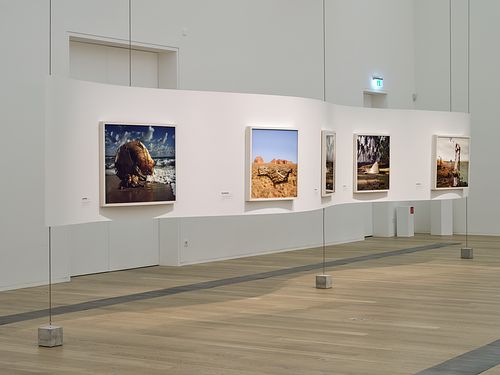AUDIO
Mary Mattingly
How are we going to live in the future? This is a question I ask myself when I look at the works of art made by Mary Mattingly, who is from the United States. As an environmental activist and artist, she developed the vision of a house worn on the body, which, at the very same time, is a coat-like garment. Between 2004 and 2009 she designed and implemented various models, all of which she documented in photographs.
For the exhibition, the artist allowed us to reproduce five of her photographs; this enabled us to avoid the costly and time-consuming transport from the US. The pictures show Mattingly’s mobile dwellings in action—at times worn on her own body. To me it is exciting that the artist embeds each of her house creations in a landscape that seems dystopian, with hardly any traces of human civilization—as if this civilization no longer existed after falling prey to a climate catastrophe.
For this very reason, Mattingly’s house suits are state-of-the-art. They can be inflated in water to be transformed into a boat. Or they can be turned into a tent. In interviews, the artist describes the technologies she has used to outfit her mobile dwellings: heat accumulators, solar cells, GPS microdevices, communication devices, Internet. What is more, the house suits are waterproof and resistant to UV rays, and they even boast a hammock.
With her smart house clothing, Mattingly touches on earlier ideas for space suits, developed in the 1960s—yet against the backdrop of present-day ecological challenges. Her suggestion to use wearable dwellings, which adapt flexibly to the human body and the landscape, raises the question of whether life without fixed architecture is possible. In the context of the exhibition, it is interesting how the fusion of clothing and dwelling become a “third skin” for humans—a process that is especially evident in Mattingly’s work.
For the exhibition, the artist allowed us to reproduce five of her photographs; this enabled us to avoid the costly and time-consuming transport from the US. The pictures show Mattingly’s mobile dwellings in action—at times worn on her own body. To me it is exciting that the artist embeds each of her house creations in a landscape that seems dystopian, with hardly any traces of human civilization—as if this civilization no longer existed after falling prey to a climate catastrophe.
For this very reason, Mattingly’s house suits are state-of-the-art. They can be inflated in water to be transformed into a boat. Or they can be turned into a tent. In interviews, the artist describes the technologies she has used to outfit her mobile dwellings: heat accumulators, solar cells, GPS microdevices, communication devices, Internet. What is more, the house suits are waterproof and resistant to UV rays, and they even boast a hammock.
With her smart house clothing, Mattingly touches on earlier ideas for space suits, developed in the 1960s—yet against the backdrop of present-day ecological challenges. Her suggestion to use wearable dwellings, which adapt flexibly to the human body and the landscape, raises the question of whether life without fixed architecture is possible. In the context of the exhibition, it is interesting how the fusion of clothing and dwelling become a “third skin” for humans—a process that is especially evident in Mattingly’s work.
